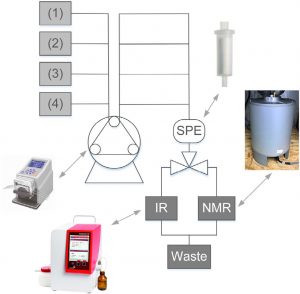The permitted hydrocarbon content of discharged water from offshore oil and gas exploration is becoming increasingly limited by more stringent legislation. This creates the demand for measurement methods that are sensitive enough to detect contaminants at ppm level, but also compact and robust to field conditions. The group of Professor Mike Johns at the University of Western Australia in Perth has developed a benchtop NMR method to quantify the hydrocarbon content in water at the ppm level.
One publication describes a method using benchtop NMR spectroscopy in combination with solid phase extraction (SPE) to to unambiguously differentiate, and hence quantitatively detect, the required oil and solvent NMR signals. The measurement process was applied to water contaminated with hexane or crude oil over the range 1–30 ppm. The results were validated against known solubility limits as well as infrared analysis and gas chromatography. Good agreement was achieved, and it is noted that the SPE-NMR method does not require optical access and is readily automated.
This method was extended in a second publication to enable the separate quantification of the aromatic and aliphatic oil content of the discharge water. Due to its much greater toxicity, the aromatic content is of increasing interest. This new methodology was successfully validated using water contaminated with a variety of aromatic and aliphatic hydrocarbons. The uncertainty related to the NMR measurements was shown to be comparable to that of sample preparation. The results were validatied against the well-established techniques of GC-FID and IR and showed generally good agreement.
See a full list of Spinsolve publications.
